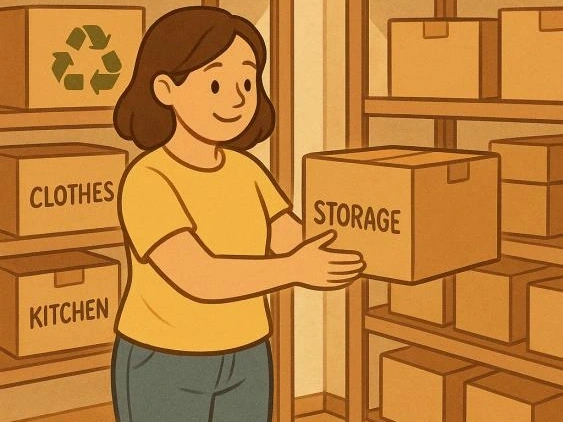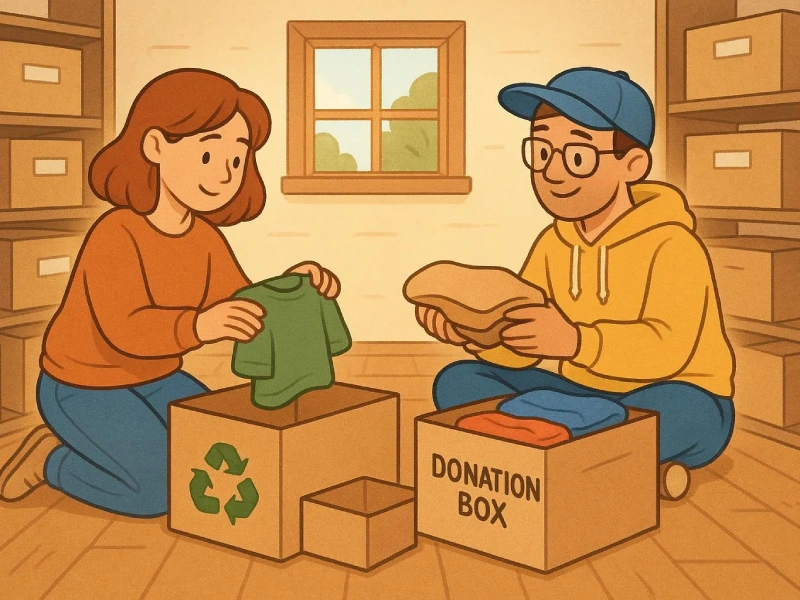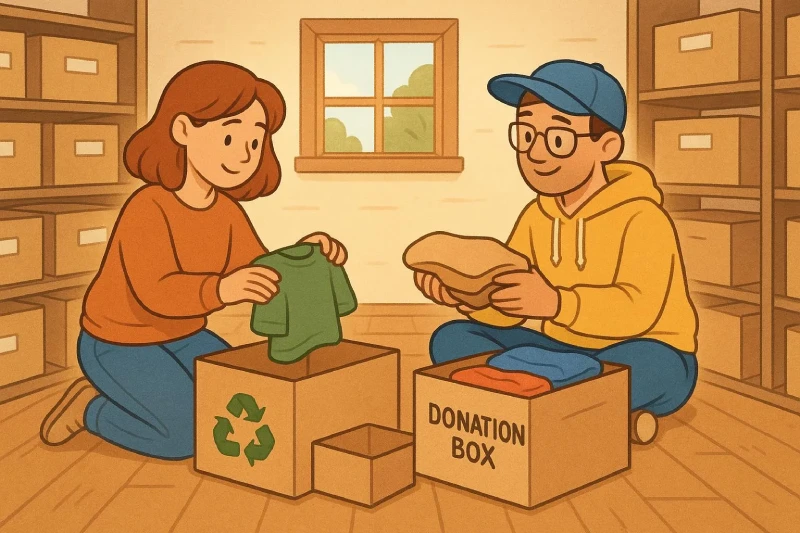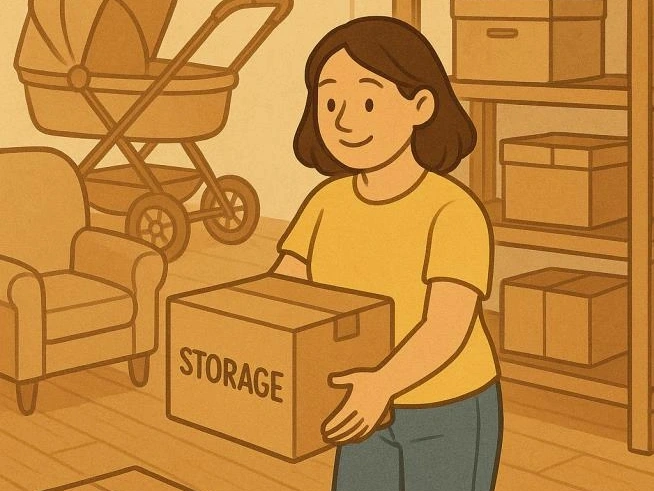Moving house, renovating, or simply clearing space can feel like a fresh start. But for many people, it also means throwing away items that end up in landfill. With landfill space shrinking and household waste increasing, it’s time to approach moving and decluttering differently. Choosing eco-friendly storage solutions can help reduce waste and support sustainable living.
Australia generates over 76 million tonnes of waste each year, according to the Department of Climate Change, Energy, the Environment and Water (DCCEEW). That figure includes furniture, clothing, electronics, and household goods that could have been reused, donated, or stored. Planning ahead and using the right strategies can help cut this number down.
Start With a Green Decluttering Checklist
Before packing begins, create a checklist that prioritises reuse, donation, and recycling. Sort items into four groups: keep, donate, recycle, and dispose. This simple step helps reduce clutter without creating waste. Be honest about what still serves a purpose and what someone else could use.
Avoid throwing everything into bins or boxes without thought. Many items hold value or function even if no longer needed in your home. This includes baby gear, seasonal clothing, sports equipment, and spare furniture. If these items might be useful later, store them securely instead of replacing them in future.
Use Storage to Support a Circular Economy
A circular economy encourages people to keep resources in use for as long as possible. Storing items for future use helps maintain their lifespan and reduces the demand for new products. Storing rarely used but still functional items supports this mindset.
A garage full of clutter isn’t helpful, but a clean, well-organised storage unit can be. You’ll avoid repeat purchases, save money, and reduce the pressure on natural resources. This is one of the most practical storage tips for sustainable living.
When choosing storage, think about access, climate control, and security. Items like prams, camping gear, or furniture benefit from conditions that protect them from moisture and dust.
Donate or Sell First, Store What Matters
If you don’t need it, someone else might. Platforms like Givit or Facebook Marketplace are ideal for giving furniture and goods a second life. You can also donate to local charities, op shops, or women’s shelters. Planet Ark offers recycling options and donation points nationwide.
Storing sentimental or practical items makes sense. But decluttering for a green move means choosing to store what’s meaningful, not what’s easy.
Store Items for Future Use
Storage becomes sustainable when it helps you keep items in good condition for later use. That means packing properly and storing thoughtfully. Furniture, baby gear, seasonal clothes, and sentimental items can all have a second life—if protected well.
Use the right-sized box for the item, and make sure it’s clean, dry, and labelled. Stacking heavier boxes at the bottom and lighter boxes on top helps prevent damage. Avoid overfilling—boxes should close easily without bulging or needing extra pressure.
Items like prams, highchairs, or occasional furniture benefit from being stored off the ground on pallets or shelving. This avoids moisture damage and makes future retrieval easier. Soft furnishings like cushions, blankets, or doonas should be stored in sealed containers or vacuum-sealed bags to reduce space and keep pests out.
Seasonal storage is another smart strategy. Whether it’s Christmas decorations, snow gear, or camping equipment, keeping these items stored securely until needed helps avoid replacing them later. These are great examples of how storage supports sustainable living and contributes to a circular economy moving guide.
Electronics and appliances should be stored with care. Remove batteries where possible, wrap cords separately, and place any manuals or accessories inside the same box. Label everything clearly. It will save time and reduce frustration later, while also reducing the risk of e-waste if you repurpose or rehome items in future.
How to Pack Without Single-Use Plastics
Plastic wrap and foam materials often end up in landfill. They’re difficult to recycle and contribute to microplastic pollution. For a cleaner move, choose materials that are easier on the environment.
If extra padding is needed, consider low-waste alternatives like shredded paper or recycled kraft paper. For fragile items, wrap in towels or place them between soft items such as blankets or clothing. This protects items while reducing the need for synthetic fillers.
Clients using storage boxes supplied by their facility should still take care to pack with minimal waste. Avoid sticky tape where possible and use recyclable paper-based labels to mark contents clearly. These small adjustments help reduce the environmental impact of each move.
According to Clean Up Australia, Australians use over 3.5 million tonnes of plastic every year, with only 13% recycled Choosing to pack consciously can help reduce this number and make your next move significantly greener.

Donate or Rehome Before You Store
Before deciding what to store, consider what you could give away. Donating or rehoming useful items is one of the easiest ways to support a low-waste move. It also keeps your storage space focused on what truly matters—items with future value or strong sentimental meaning.
Old furniture, toys, clothing, and appliances are all welcome at many local organisations. Instead of adding to landfill, these items can help someone in need. National charities like the Salvation Army, Vinnies, and Lifeline accept furniture and household goods in good condition. Some offer pick-up services, which makes the process even easier.
If your item doesn’t meet donation guidelines, look into community groups such as Buy Nothing or local Freecycle pages. Facebook Marketplace is also an excellent tool for giving away unwanted items quickly and locally. These options support a circular economy by keeping products in use for longer.
The website Recycling Near You by Planet Ark is a reliable resource for checking what can be donated, recycled, or repaired. It lists local op shops, council depots, and specialised programs by location. This helps you find a home for nearly anything—from mattresses to old tech.
Be Mindful With Sentimental Items
Some things are simply too meaningful to donate or discard. Baby clothes, family heirlooms, childhood art, or inherited furniture often carry deep emotional value. These are ideal items to store—especially if they won’t be needed daily but hold importance over time.
To protect sentimental pieces, store them in durable containers. Wrap delicate items in soft fabric and label boxes clearly. Add notes or memory tags to boxes so future you can quickly recall what’s inside. This prevents boxes being forgotten or thrown out later.
Consider photographing items that are meaningful but not practical to keep. This helps you hold onto the memory without needing physical storage space.
Plan Your Storage Layout for Easy Access
Whether you’re storing for a few months or several years, your storage unit should be easy to use. Place frequently accessed items toward the front and stack seasonal or rarely used boxes at the back. Use clear labelling and group similar items together. This approach reduces the risk of duplicate purchases and supports storage tips for sustainable living.
A well-planned unit saves time, stress, and space. It also helps you get the most from your storage investment—without unnecessary waste or forgotten items.

Use Storage to Avoid Repeat Purchases
One of the most practical benefits of storage is the ability to hold onto items you’ll need later. This might include extra homewares, children’s gear, seasonal sports items, or clothing between sizes or seasons. Keeping these items accessible and in good condition prevents the need to buy them again.
Unplanned repurchasing adds clutter and increases household waste. It also contributes to the rising volume of furniture and textiles entering landfill each year. According to the Australian Bureau of Statistics, households dispose of more than 500,000 tonnes of furniture annually, much of it in usable condition. Storing items properly supports waste reduction and long-term financial savings.
Storage gives you the space to pause before discarding. It allows time to decide what holds real value—both practical and emotional. Whether you’re renovating, moving, or simply decluttering, using storage as part of a thoughtful plan helps reduce impulse decisions.
Stay Accountable With a Green Moving Checklist
A checklist is more than a list of tasks. It’s a tool that helps you stay accountable to your values during a busy and often stressful time. A green decluttering checklist can remind you to:
- Donate first
- Recycle properly
- Label for later use
- Avoid single-use plastic
- Store only what’s meaningful
Use your checklist to plan ahead and avoid last-minute dumping. Add links to local donation centres, recycling depots, and storage access times so everything stays organised. A printable or digital version can also be shared with family or housemates to keep everyone aligned.
Final Thoughts: Decluttering With Care
Decluttering doesn’t have to mean dumping. With a little planning and intention, it can be a step towards a more mindful and sustainable lifestyle. Choosing eco-friendly storage solutions supports the environment and helps you feel more in control of your move.
Whether you’re downsizing, renovating, or preparing for a new chapter, using storage wisely reduces waste and stress. Each box stored with purpose is a small win—for your future self and for the planet.
Remember, your space tells a story. Make it one that reflects care, thought, and sustainability.
For more eco-conscious moving resources, visit the Australian Government’s YourHome platform. It offers practical tips on moving house sustainably and reducing waste at every stage.



